How Media, PA, Homeowners Can Prepare for Thunderstorms and Severe Weather
8/20/2021 (Permalink)
Blog Summary: SERVPRO of Media highlights safety practices from the Red Cross. These tips can help people stay safe during a thunderstorm.
Storm damage in Media, PA, can be a frightening and stressful experience for homeowners. However, by following thunderstorm safety tips and best practices, homeowners can help minimize or prevent property damage caused by severe weather.
What Constitutes Severe Weather?
According to the Red Cross, “A thunderstorm is considered severe if it produces hail at least 1 inch in diameter or has wind gusts of at least 58 miles per hour. Every thunderstorm produces lightning, which kills more people each year than tornadoes or hurricanes. Heavy rain from thunderstorms can cause flash flooding, and high winds can damage homes and blow down trees and utility poles, causing widespread power outages.”
Before the Thunderstorm
Make sure all family members are equipped to meet the challenges posed by severe weather. Talk about storm safety with everyone in the household; even younger children can absorb age-appropriate safety tips. The individuals in the home should be very familiar with the following strategies:
- The designated place in the home for the family to shelter in during a storm (Generally, windowless bathrooms are considered a good place to shelter.)
- The evacuation plan should the family need to leave the house
- The protocol for reestablishing contact if family members are separated
In addition, put together an emergency kit, as well as a first aid kit. In order to use the first aid kit correctly, obtain first aid training, which could save lives in the aftermath of storm damage. Homeowners also can benefit greatly from online resources put out by reputable organizations like the Red Cross. Detailed storm safety checklists can help families identify the best strategies for weathering a storm. Look into weather and emergency apps for mobile devices; these valuable tools can give people a real-time look at how the storm is progressing.
Outside the home, remove dead or weak branches from trees and shrubs. Trimming the greenery will make it more resistant to gusts of wind. Identify outdoor living items that need to be brought inside or into the garage so that they will not be blown away by high winds and become projectiles that can damage houses.
During the Thunderstorm
If a thunderstorm is in the forecast, follow local news reports, weather apps on mobile devices, or the NOAA Weather Radio for storm updates. Cancel any planned outdoor activities to reduce the risk of injury. If thunder can be heard, people are at risk of being struck by lightning. National Weather Service recommendations advise people to remain inside for a minimum of thirty minutes following the last instance of thunder.
Remember, a severe thunderstorm watch indicates that conditions are present for a severe thunderstorm to potentially develop, while a severe thunderstorm warning indicates that a severe thunderstorm has actually been detected on radar or observed by storm spotters. By paying attention to warnings and taking the appropriate actions, homeowners can save lives and protect property.
In the event that a warning is issued, shelter in a sturdy structure. Evacuate mobile homes, which are susceptible to damage from high winds. Stay away from windows, doors, or skylights, which contain glass that is easily broken and could lead to cuts and lacerations. Do not bathe or shower. Avoid using plumbing.
After the Thunderstorm
If someone is struck by lightning, they will need emergency medical care, so call 9-1-1 immediately for lightning strike injuries. Since lightning strike victims do not retain an electrical charge, bystanders can check the injured person for burns, cuts, or other injuries. If the person is not breathing, CPR can be administered by an individual who has been trained in proper CPR techniques.
In the case of downed power lines or trees that have fallen on power lines, stay at a safe distance and report the situation immediately. When driving soon after a thunderstorm, never drive across a roadway that has been flooded. The depth of the water cannot accurately be gauged, and vehicles could be swept away by floodwaters.
Check for updates from local television channels, local radio stations, and NOAA Weather Radio. Local updates are especially important for determining the location and extent of road blockages, power outages, and similar information.
After storm damage, scammers are active, so homeowners should only trust a reputable, established storm damage restoration company to provide damage restoration services. SERVPRO of Media is a locally owned and operated business and has been serving the local community for 27 years. When thunderstorms damage homes or businesses in Broomall, PA, or the surrounding area, homeowners can turn to SERVPRO of Media for rapid, reliable restoration services.
For more details about storm damage restoration in Media, PA, contact SERVPRO of Media by email at office@SERVPROmedia.com or by phone at (610) 566-5720






 24/7 Emergency Service
24/7 Emergency Service
